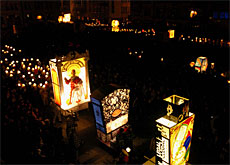
Lanterns shed light on carnival spirit

Basel's Fasnacht is the biggest, oddest and yet somehow the most Swiss of the carnivals in the country.
Stars of the show on opening day are the giant painted lanterns lampooning events and people who made the headlines over the past year.
“It’s all about the light,” says Astrid X (name changed), the artist who has painted two of this year’s lanterns, referring to their symbolic importance.
“The carrying of fire or light during festival processions goes back to the Middle Ages.”
Lanterns replaced torches in the 19th century, and provide Basel’s Fasnacht with its unique flavour.
There are many strict rules and regulations governing Fasnacht, and each of the 200-odd cliques or clubs must carry a painted lantern during Morgestraich – the early morning procession that kicks off the three-day festival.
Lights out
With the lights of the city switched off, the lanterns illuminate the path of the thousands of costumed marchers, playing fifes (see video) and drums.
The penchant for order and precision seems very Swiss, but there are no holds barred when it comes to the sujet or theme painted on the lanterns.
The cliques never reveal the names of the artists hired to paint the lanterns and keep the sujet secret up to Morgestraich.
Many lining the narrow streets of Basel’s old town to watch the parade rise early to see who or what is being lampooned.
This year, Astrid’s lantern takes a shot at a politician from the rightwing Swiss People’s Party who failed to be elected to the local council. The sujet selected by the clique pokes fun at the woman many in Basel love to hate.
“She doesn’t appear on the lantern, which is practically the most nasty thing you can do in carnival – to be suggestive but not to show her,” she says, laughing.
“This is pretty difficult to do but we managed it in such a way so you know what it’s about and you try to find her, but she’s not there.”
Honour
“To be on a lantern at the carnival even for the wrong reason is an honour. But this would have been too much of an honour for her,” explains Astrid X.
Astrid’s second lantern has a go at the Swiss government’s efforts to reform the army. On the back of the lantern, a knight in armour dances with Mahatma Gandhi above multicoloured helmets of Swiss soldiers.
It begs the question whether the Swiss armed forces will in future be a peace (represented by Gandhi) or a war corps (knight).
“Are they dancing a peace waltz or is it a war tango?” asks Astrid, explaining that the sujet is “desert, backward, march”.
She has worked non-stop for weeks to finish these works of art that will only have a shelf life of three days, the span of carnival.
“We realise that it’s not very long but we also know that tens of thousands of people will see them, even though we as artists don’t get any recognition because we remain anonymous.”
Anachronism
“It’s an anachronism,” says artist Linda Y, whose lantern lampoons doping scandals in sport by putting Fasnacht figures in the shoes of top athletes, shooting up drugs in order to get through the arduous days of carnival.
“The paintings are a lot of work for just three days,” she says. “But that’s true for everything at carnival, and that’s what I like most about it because it’s usually the other way around in our society today.
“Goods are not made very well so they can be sold cheaply and yet are expected to last a long time.”
Linda’s lantern is dominated by an oversized Wonder Woman, holding a syringe in one hand.
The smaller figures running about between her legs are based on works by the Flemish artist, Pieter Bruegel the Elder.
Blind leading blind
The section of the lantern showing a line of Fasnacht fools leading each other into a drug bust are similar to the characters in Bruegel’s The Blind leading the Blind.
After the final brushstrokes, Linda and Astrid have to add the satirical verses explaining the sujet, which are normally written by a select member of the clique.
On the second day of carnival, the works of art take pride of place once again when they are put on display in the big square in front of Basel’s cathedral.
After that, the lanterns are extinguished for good.
swissinfo, Dale Bechtel in Basel
Basel’s Fasnacht is the best known of Switzerland’s many carnivals.
While most carnivals take place in the days leading up to Ash Wednesday, Basel’s version always begins on the Monday after.
One of the unique aspects of Basel’s carnival is the large lanterns illustrated with cartoons which lampoon events and people who made the headlines over the past year.

In compliance with the JTI standards
More: SWI swissinfo.ch certified by the Journalism Trust Initiative


























You can find an overview of ongoing debates with our journalists here . Please join us!
If you want to start a conversation about a topic raised in this article or want to report factual errors, email us at english@swissinfo.ch.